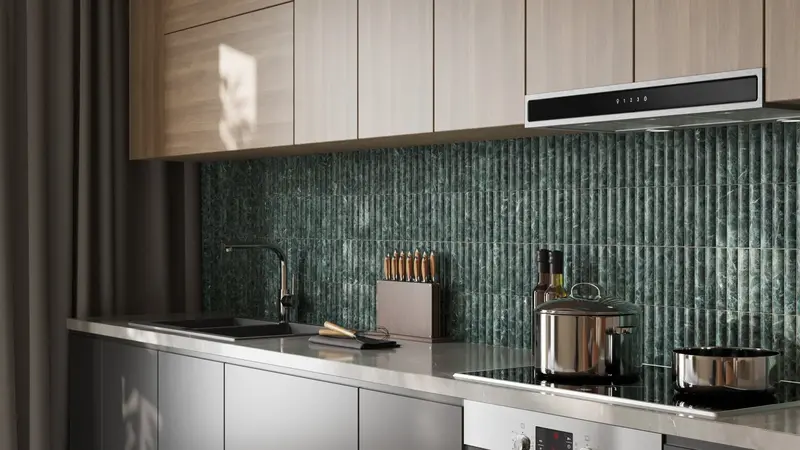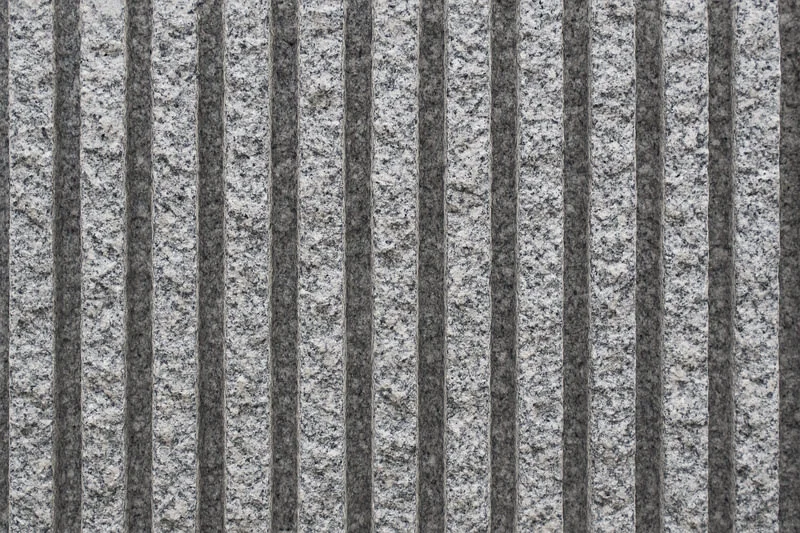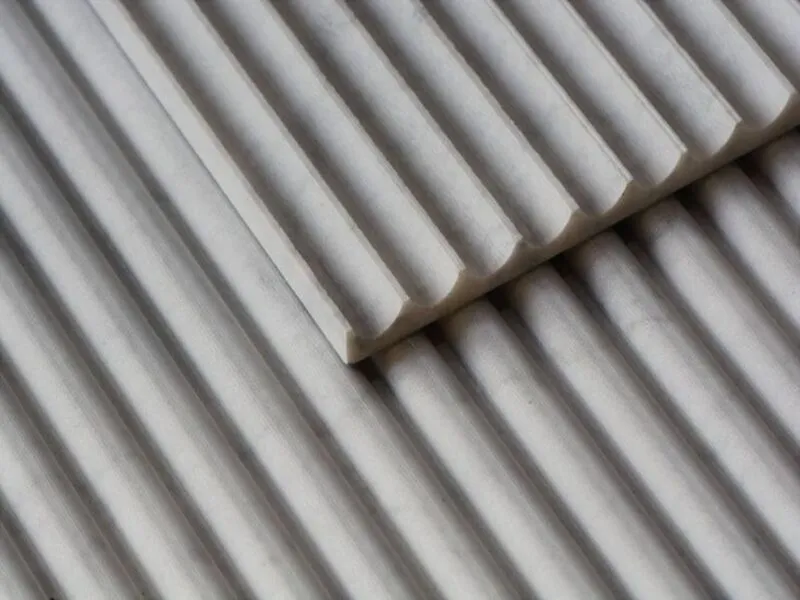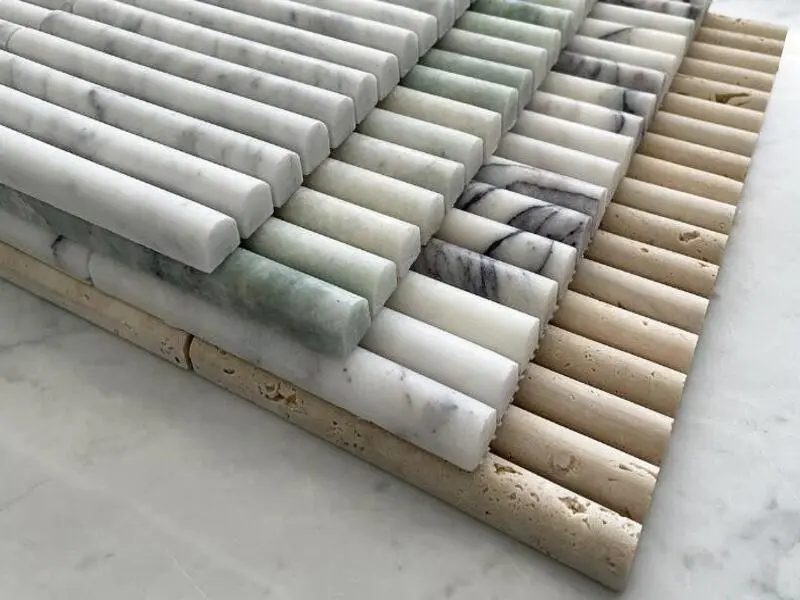
When you walk into a room, the surfaces around you speak. Some whisper elegance. Some shout drama. Fluted stone made of granite, marble or any other natural stone, does both — in a subtle, sculptural way. At Stone Galleria, we believe every wall, column, and panel has the potential to become a statement piece.
Imagine a smooth granite wall. Now, instead of being completely flat, it has a series of grooves or ridges running across it. These grooves can be inward curves (concave) or outward bumps (convex). The play of light and shadow along these grooves gives the wall depth, texture, and movement, even though it’s a single piece of stone.
What is Fluted Granite?
Fluted granite is granite that has been carefully machined with a series of parallel, grooves or channels—mostly vertical or horizontal - to create a textured, three-dimensional surface. This “fluting” effect adds depth and movement to the granite, transforming flat slabs or tiles into visually striking architectural elements.
Fluting represented refinement, rhythm, and movement—mimicking organic forms like reeds and tree trunks, connecting architecture to nature.
There is another pattern called Ribbed Granite that is often confused with Fluted Granite. Both sound similar and even share a linear surface design, but there’s a subtle difference in how they’re made and how they look.
Let’s understand what Ribbed Granite is and how it differs from Fluted Granite.
What is Ribbed Granite?
Ribbed granite and fluted granite differ primarily in the shape and feel of their surface patterns, even though both are types of decorative textured granite finishes involving linear grooves or ridges.
Ribbed granite has raised, convex linear ridges or ribs running across the stone surface. These ribs tend to be sharp, structured, and create a pronounced 3D texture that plays with strong shadows and depth. It gives a bold, modern, and industrial design impact and is commonly used for exteriors, landscaping, and accent walls where a textured statement is desired.

Ribbed Granite Vs. Fluted Granite
| Feature | Fluted Granite | Ribbed Granite |
|---|---|---|
| Pattern type | Grooves cut in (concave) | Ridges raised out (convex) |
| Texture feel | Smooth and wave-like | Sharp and structured |
| Design style | Classical / Contemporary | Modern / Industrial |
| Light play | Subtle shadows and highlights | Strong shadows and texture depth |
| Common usage | Facades, columns, indoor walls | Exteriors, landscaping, bold walls |
Both finishes enhance granite’s natural durability, depth, and aesthetic appeal, but they suit different architectural moods. Fluted granite is desired for a softer, elegant flow, or ribbed granite for a bolder, more tactile statement.
Fluting: Pattern, Profile, or Design?
Fluted granite is more than just grooves on stone — it’s a versatile architectural surface that combines texture, depth, and light play. Designers love it for walls, facades, columns, and feature panels because it turns ordinary stone into a luxurious 3D statement.
1. Fluted Granite Orientation
Fluted granite panels can be customized in multiple directions:
- Vertical Fluting: The vertical stone grooves enhanced light play, making columns & walls appear straighter, taller, and more graceful than smooth surfaces.
- Horizontal Fluting: Adds visual width and flow; ideal for reception walls or counters.
- Diagonal Fluting: Introduces dynamic, modern angles for contemporary designs.
- Wavy Fluting: Organic, flowing patterns that create softness and movement.
2. Concave vs Convex: Choosing the Right Groove Profile
The profile of the grooves defines the visual and tactile effect:
- Concave Fluting: Inward-curving grooves (“U” shape) that cast shadow and add depth.
- Convex Fluting: Outward-curving ridges that catch light and give a sculptural look.
- Mixed Profiles: Combining concave and convex fluting adds dynamic 3D texture and sophistication.
| Type | Curve Direction | Effect on Surface | Example Use |
| Concave Flutes | Inward (“U” shape) | Shadowed grooves, sculpted depth | Classical columns, textured feature walls |
| Convex Flutes | Outward (“ridge”) | Raised ridges, tactile look | Modern interiors, accent walls, furniture panels |
3. Customization Options
Fluted granite allows precise customization to match your design intent:
- Alternating Widths: Grooves or ridges can vary in width for unique rhythm and pattern.
- Variable Depth (Concave): Deeper grooves create stronger shadows; shallower grooves are subtle.
- Variable Height (Convex): Taller ridges catch more light and create a tactile experience.
- Pattern Alternation: Mix widths, depths, heights, and profiles to create artistic feature walls.
Even a simple wall can become a piece of art when the profile, direction, and groove dimensions are thoughtfully designed. Width, depth, height and spacing of grooves can be varied to create custom textures.

Why Fluted Design on Stone Is Loved by Designers and Homeowners
Fluted granite panels do more than look beautiful.
- Texture without clutter: The flutes add tactile interest without overwhelming a space.
- Light and Shadow Dynamics: Grooves and ridges catch light differently, creating a dynamic wall that evolves from morning to night.
- Versatility: Can be paired with smooth stone, wood, or metal for layered design impact.
- Luxury Appeal: A natural, durable stone that conveys sophistication.
- Architectural Influence: Inspired by classical Greek and Roman columns, fluted tiles adds charm & elegance to modern spaces. The textured grooves bring out the stone’s natural veining and beauty.
- Versatility and Material Adaptability: Fluted designs are not limited to marble; granite, limestone, and engineered stones are also used, allowing for wide-ranging applications from kitchen countertops to feature walls and exterior facades .
- Statement Feature: It elevates ordinary stone into a luxurious focal point, making it a favorite choice for standout design in homes and commercial spaces.
For designers, fluted stone is also a tool to alter perception. Vertical flutes can make ceilings appear higher, while diagonal or wavy patterns introduce energy and movement into an otherwise static space. Alternating widths, depths, and heights allow for a custom rhythm, echoing classical columns yet perfectly suited for modern architecture.
ALSO READ | Top Black and White Granite Types: With Veins, Salt & Pepper and Swirls Patterns
Historical Origins of Fluting in Stone Design
Fluting is not a new design concept — it dates back over four millennia, with origins in ancient Egypt and refinement by the Greeks and Romans. While it lost prominence during the Medieval era, as architecture shifted toward simpler, heavier stone masonry, it resurfaced during the Renaissance and Neoclassical periods as a nod to classical beauty and proportion.
The historical use of fluting in architecture stems from its dual purpose — functional realism and aesthetic grace. It evolved from imitating natural wooden textures in early civilizations to becoming a hallmark of grandeur in classical and neoclassical design, symbolizing rhythm, strength, and the enduring dialogue between structure and ornament.
Today, fluting has regained popularity in modern architecture and interior design — not just in columns, but in stone cladding, wall panels, kitchen backsplash, furniture fronts, and facades. Designers now use both concave and convex fluting to add rhythm, texture, and light-play to minimalist spaces. In essence, it’s a timeless technique finding fresh expression in contemporary materials and forms.
ALSO READ | Top Black Granite with Gold Elements: Veins, Flecks & Patterns for Stylish Interiors
Top Applications of Fluted Tiles & Slabs
Fluted tiles and slabs are highly versatile, transforming interiors and exteriors with texture, light play, and architectural depth. Here are common and impactful application areas:
1. Flute Wall Panels for Feature Walls
Fluted wall cladding has become one of the most stylish ways to add depth and texture to modern interiors. These fluted walls—made from stone panels like granite, marble, or sandstone—create a luxurious, three-dimensional look that instantly elevates any space.
Whether used as flute wall panels behind TV units, bed backdrops, or reception areas, the soft grooves play beautifully with light and shadow, turning a plain surface into a fluted feature wall that feels rich and sculptural.
For interior use, marble fluted panels and granite wall panels are most popular, adding natural charm to living rooms, hallways, and bedrooms. These fluted panels for walls not only increase the looks but also add texture, creating a refined fluted wall décor effect.
2. Pillars & Columns
- Fluted tiles can wrap around cylindrical or square pillars, instantly elevating them from plain to architectural.
- Especially seen in hotels, villas, and corporate buildings.
3. Bathroom Walls
- Fluted textures on accent walls in bathrooms create a spa-like, organic luxury feel.
- Stone-based ones (like granite or quartzite) also handle moisture very well.
4. Kitchen Backsplashes & Islands
- Subtle vertical or horizontal fluting adds modern sophistication.
- Works best with matte or honed finishes for an elegant, tactile surface.
5. Furniture & Counter Fronts
- Used creatively on bar counters, kitchen islands, or even wardrobes and bed frames.
- Adds depth without being loud — perfect for minimalist interiors.
6. Exterior Facades & Boundary Walls
Fluted wall panels are now widely used on exterior facades and boundary walls. When made from stone or granite, these fluted exterior panels bring a clean, linear texture that breaks the monotony of plain walls.
Architects often use stone wall panels for exterior applications to create rhythm and shadow through light play. Granite wall panels also called as "granite cladding" for exterior walls", offer long life and a natural stone finish, making them suitable for large buildings, compound walls, and outdoor feature areas.
Whether used as fluted wall panels exterior or full textured stone walls, this design approach adds structure and flow to modern facades.

Alternative Material Choices to Fluted Granite
While fluted granite is popular for its strength and natural texture, there are several other materials used to achieve that same ribbed, grooved look — each with its own character, price range, and application suitability. Choosing the right fluted material depends on the specific requirements of your project, including location, aesthetic preferences, and budget.
1. Fluted Marble
- Best for: Luxury interiors, lobbies, and premium residential spaces
- Offers unmatched elegance and veining patterns.
- Softer than granite, so better suited for interior walls than exteriors.
- Popular choices: White marble, Travertine, Italian beige tones (like Crema Marfil or Botticino).
Pros: Luxurious, smooth polish, visually striking.
Cons: Expensive, softer and needs more maintenance.
2. Fluted Sandstone
- Best for: Exterior cladding, garden walls, and rustic interiors
- A natural and earthy alternative to granite.
- Excellent workability for custom groove designs.
- Popular in India and Middle East architecture.
Pros: Warm tones, easier to carve, cost-effective.
Cons: Porous, needs sealing in damp or polluted areas.
3. Fluted Quartzite
- Best for: Facades and interiors where both durability and elegance are needed
- Hard as granite but more translucent and exotic-looking.
- Great for premium projects wanting a “soft stone look” with granite-level performance.
Pros: Durable, luxurious, often backlight-friendly.
Cons: Pricier and limited availability.
4. Fluted Ceramic or Porcelain Tiles
- Best for: Budget-friendly indoor applications
- Widely available and easy to install.
- Comes in many textures — marble, stone, or concrete look.
Pros: Lightweight, low cost, consistent look.
Cons: Feels artificial, limited size, not ideal for exteriors or large-scale façades.
5. Wooden or MDF Fluted Panels
- Best for: Indoor wall décor and furniture fronts
- The easiest way to add warmth and rhythm to interiors.
- Available in natural wood veneers, laminates, or PU-painted MDF panels
Pros: Warm, trendy, easy to install.
Cons: Not water-resistant, limited life compared to stone.
Material Comparison: Fluted Granite vs. Other Options, Which One’s Right for Your Space?
| Material | Ideal Use | Durability | Aesthetic | Maintenance | Cost Level |
| Fluted Granite | Exteriors, facades, high-traffic areas | ★★★★★ | Natural, bold, timeless | Low | $$$ |
| Fluted Marble | Interiors, luxury spaces | ★★★ | Elegant, veined, luxurious | Medium | $$$$ |
| Fluted Quartzite | Interiors & Exteriors, luxury spaces | ★★★★★ | Durability of granite & looks of marble | Low | $$$$$ |
| Fluted Porcelain Tile | Backsplashes, accent walls | ★★ | Versatile, modern | Very Low | $$ |
| Fluted Travertine Tile | Interiors, rustic themes | ★★★★ | Warm, earthy, textured | Medium | $$$$ |
| Fluted Ceramic Tile | Budget-friendly interiors | ★★ | Smooth, uniform | Very Low | $ |
| Fluted Terrazzo Tile | Artistic, decorative walls | ★★★ | Colorful, speckled, artistic | Medium | $$$ |
| Wood/MDF | Interior | ★★ | Warm, cozy | High | $ |
| Sandstone | Interior and Exterior | ★★★★ | Earthy, rustic | Low to medium | $$$$ |
- Fluted granite combines natural strength with textured beauty, making it ideal for outdoor applications such as patios, walkways, driveways, pool surrounds, and garden features.
- Natural stones like marble and sandstone are also popular for interiors, but for long-lasting outdoor use, granite offers unmatched resistance to weather, scratching, and wear. Premium alternative:
- Fluted granite and other natural stones are emerging as luxurious, durable options that surpass ceramic tiles in resilience, with the same textured appeal and added natural character.
Why Choose Fluted Granite from Stone Galleria
Fluted granite isn’t just a design trend — it’s a timeless expression of texture and form. At Stone Galleria, we’re excited to bring this craftsmanship to life through our upcoming collection of fluted tiles in granite, marble, sandstone, and quartzite.
Each piece is carved directly at our factory using advanced technology to ensure precision, consistency, and finish. From quarry selection to fluting, finishing, and delivery, we handle everything in-house — giving you a ready-to-install product that arrives directly from our factory to your project site.
Whether you’re designing a façade, feature wall, or statement column, we help you customise the fluting on the stone of your choice — perfectly aligned with your architectural vision.







![Latest GST on Granite Slabs & Blocks [2025 Chart + HSN + Price Examples]](https://stonegalleria.in/admin/images/blog/latest-gst-on granite.webp)








